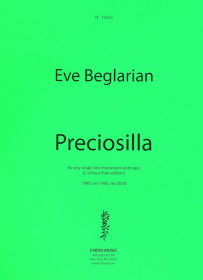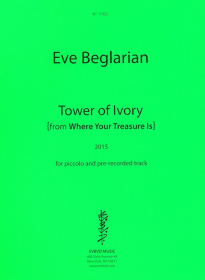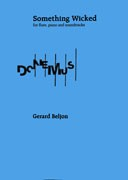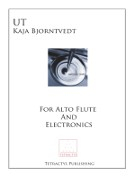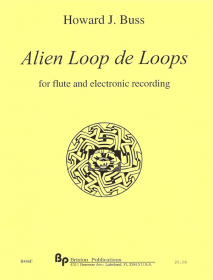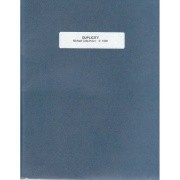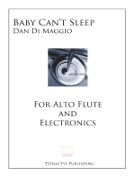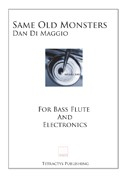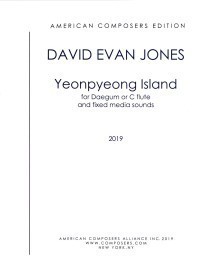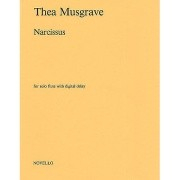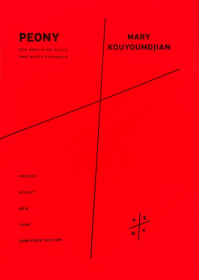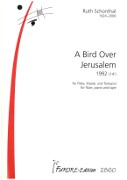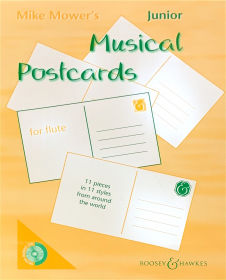Flute & Electronics
-
Anderson, C :: glass ceilings
glass ceilings
Anderson, C
'Glass Ceilings' was written as part of a commission-performance project initiated by Claudia Anderson in late 2019, requesting four-minute works from a group of four notable women composers to include in performance with 'Glass Ceilings.' 2020’s abrupt overthrow of our way of life had an inevitable effect on all of our works, and each composer in her own way incorporated the horrors of the pandemic and racially motivated violence that defined much of that year. Reflecting on those populations who were most at risk from disease and violence, who were front-line workers due to their social and financial status, 'Glass Ceilings' is dedicated to all of them.
-
Beglarian, E :: I Will Not Be Sad In This World
Based on an Armenian troubadour song, I WILL NOT BE SAD IN THIS WORLD is a uniquely beautiful work for alto flute (or bass flute) accompanied by a pre-recorded audio track made purely from the composer’s own singing. The result is a fluid interplay between the live flute and the composer’s multi-tracked and processed vocal sonorities. The work was created for Marya Martin’s Eight Visions collection (published by Presser), and is now available as a single publication.
Please note this publication includes a score only and no separate flute part.
-
Beglarian, E :: Preciosilla
Preciosilla is a song setting of Gertrude Stein’s poem that places the text in the realm of the rhythm section instead of in the realm of the melody where lyrics are conventionally found. The composer’s reading of the text was sampled by an Akai S1000. The flutist’s melody has quotes from pop love songs and other familiar music embedded in musical stream-of-consciousness writing that attempts to emulate Gertrude’s handling of text.
-
Beglarian, E :: Tower of Ivory
Tower of Ivory, for piccolo and pre-recorded track, is one of a series of pieces in an ongoing project called Where Your Treasure Is, about the gradual decay of a large painting of an Irish burial mound. Each piece in the four-part series is a meditation on a text from James Joyce’s Portrait of the Artist as a Young Man. The music for Tower of Ivory takes off from an Irish traditional tin whistle tune known as Salamanca.
-
Beljon, G :: Something Wicked
Something Wicked
Beljon, GGerard Beljon presents Something Wicked, for flute, piano, and electronics.
Something wicked is music about witches and witchcraft. In the music first an enchanting spell is wrought, slowly bringing to life something horrible. When the spell is cast eventually, a wild dance starts in which even the witches themselves are unable to control what they have just created. No electronic sounds have been used on the CD that accompanies the live instruments. All sounds are natural samples. Except for the vocal effects, all samples have been derived directly from the flute and the piano.
Duration: 10'. For advanced players.
-
Bjorntvedt, K :: Ut
Ut
Bjorntvedt, K
The title Kaja Bjorntvedt s Ut, for alto flute and electronics, stems from the syllable formerly used in solfege to represent the key note of the Ionian mode (the major scale), now replaced by do . The piece Ut evolves around the key note of the E flat major scale, also moving on to other medieval modes.
Ut is written as a solo piece for alto flute, yet it forms a duet with a pre-recorded and processed tuba part. However, in spite of the fixed nature of the tape, the piece will never sound the same twice, as there are several improvised sections where the performer has to choose how to respond to the tape part.
-
Brown, E :: Arcana
Elizabeth Brown presents Arcana, for flute and recorded sound. In Arcana, for solo flute and recorded sound, the ghostly voice of the theremin shadows the melancholy and lyrical solo flute through a dark soundscape. Written in Brooklyn, NY in 2004, Arcana was commissioned by Itzhak and Toby Perlman for the 21st birthday of their daughter, flutist Ariella Perlman. Ariella performed the premiere at Rice University in Houston on April 1st, 2006. Arcana is now frequently performed around the world. Duration: 9’30.
-
Buss, HJ :: Alien Loop de Loops
Alien Loop de Loops
Buss, HJALIEN LOOP DE LOOPS for flute electronics, by Howard Buss, is a fantasy that appeals to a wide range of audiences. Buss envisioned a flutist playing during an air show by an alien craft. At first the flute is unaccompanied, but then is joined by the recording that includes traditional instruments, an 'alien' voice, the spacecraft, and electronic effects.
-
Casserley, L :: The Monk's Prayer
The Monk's Prayer
Casserley, L
This piece requires a multi-tapped delay system with seven taps at times corresponding to 5, 8, 17, 23, 36, 52 and 81 quaver beats of the score. At quarter note= 50 these times are: 6, 9.6, 20.4, 27.6, 43.2, 62.4, and 97.2 seconds respectively. Feedback paths to the input of the delay are provided from the 5 and 81 beat outputs. Three pitch shifters are placed at the 23, 36, and 52 beat outputs, with shifts of -9, -6, and +4.5 semitones respectively. Level controls are required for the source input signal, the seven delayed signals and the two feedback signals, ten controls in all ... The system may be realized by linking several delay units and a small mixer, but the simplest way to achieve this is by using the program available from the publisher. Source code and full technical data is supplied. Other implementations are, of course, possible. -
Chambers, M :: ...Glass Darkly...
...Glass Darkly...
Chambers, MMark Chambers Glass Darkly for alto flute, piano, and electronics.
From the composer:
Theological reflection in music has been an interest to composers such as Bach, Mendelssohn, and Messiaen, as well as others. I also have been influenced by my theological interests which is brought out quite deliberately in glass darkly
glass darkly is the first work in which I have utilized computer software from IRCAM (Institut de Recherche et Coordination Acoustique/Musique.) Though the work is influenced and borne out of electronic music techniques it is not a work that is cold and lifeless. It is highly structured in terms of form and harmonic content yet contains moments of quiet reflection that are contrasted with episodes of dramatic peaks.
I then thought of the passage from I Corinthians. If one were to explore in musical terms what this passage means how would that affect the outcome? How does one see into eternity with mortal eyes? What do we see when we look through a glass darkly? As I considered my material in light of this passage I thought it best to fit the material to the particular instruments. To do this I needed to round up the various microtones so they would fit the given instrument. So for example say one tone had a frequency of 427.65 Hz (the half-way point between G# - 415.30 Hz and A 440 Hz.) I could keep the pitch for the flute, as it can readily play quartertones, but I would then round up the pitch to 440 Hz for the piano. I then added an electronic portion to the music to further realize the other microtones that the flute couldn t play.
The result of all this is that there are three layers that are incomplete reflections of the each other.
-
Colquhoun, M :: Duplicity
Duplicity
Colquhoun, M
Note: this piece is for flute and digital delay.
'The digital delay used in the performance of this piece must have the capability to do a few very specific tasks, and there are a number of brands and models that will be perfectly satisfactory. The delay must be able to:
1. play back your flute sounds at a rate of 450 milliseconds;
2. play back at a rate of 3600 milliseconds;
3. without interrupting the sound, go from one rate to the other both very quickly and rather slowly; and
4. have a repeat/hold feature.
'The entire setup consists of the delay unit, a microphone and stand, a good quality PA system, and whatever cables and pedals may be necessary.' -
-
Di Maggio, D :: Baby Can't Sleep
Baby Can't Sleep
Di Maggio, DDan Di Maggio s Baby Can t Sleep, for alto flute and electronics.
From the composer:
Basically, this piece is my first encounter with the alto flute. Scored for alto and tape, it is intended as a playful piece for this wonderful instrument. Basically it is a funny way to talk about sleep problems. The musical speech of the flute is disturbed by the sounds and noises from the tape. An Optional Background Trouble maker could also take part in the performance... With this piece I had my first premi
-
Di Maggio, D :: Same Old Monsters
Same Old Monsters
Di Maggio, D
Dan Di Maggio presents Same Old Monsters, for bass flute and electronics.
From the composer:
I m going to record a concept album called Monsters, someday. Same Old Monsters will be the main composition, along with Bardhezi, for unaccompanied voice, with which it forms a diptych. The title suggests that the characteristics of human violence, oppression and malice are the same over the centuries. The idea of the piece is an activity that requires attention, delicacy and commitment (the bass flute part, with its rhythmic intricacies, quartertones and multiphonics), opposed to the obtuse brutality of the Same Old Monsters. Our antihero tries to resist and to fight back, but at the end gives up, and his voice becomes nothing but an inarticulate babble. The final version of the score was done with technical supervision by Carla Rees.
Duration: 9 . For the advanced player.
-
Dick, R :: Techno Yaman
Techno Yaman
Dick, R
Note: Techno Yaman is a piece that blends aspects of the traditional North Indian raga Rag Yaman with rock and electronica. To perform the piece, the flutist also 'plays' an electric keyboard that contains a drum machine. The keyboard must have an 'organ' tone and these drum machine patterns or equivalents: basic 4/4 rock, Samba, Shuffle. -
Gardner, A :: Fade
Alexandra Gardner presents Fade for flute and soundtrack.
From the composer:
'Fade was commissioned by the National Flute Association for the 2019 Young Artist Competition. It is the 12th work in my series of compositions for solo instrument with electronics. As is my habit with these pieces, the two parts are woven together into an aural landscape of shifting rhythms and textures based upon the sonic material of the acoustic instrument. The electronic part of Fade is comprised entirely of acoustic flute sounds, some of which are easily identifiable, and others of which have been processed into completely different forms using a variety of software tools. The work is an exploration of the nature of human memory; which memories 'stick' with us, the ways in which memories transform and mutate over time, and how they can seem to vanish, only to reappear at later unexpected moments.'
Duration: 6'43. For the advanced player.
-
Gibson, R
Yeonpyeong Island
Jones, DE
David Evan Jones presents Yeonpyeong Island for flute and electronics.
Yeonpyeong Island (2011) is one of a series of recent compositions that use computer processed versions of actual news broadcasts in combination with live instruments. These pieces transform reports of some of the difficult news of our day and bring them into the contemplative frame of the concert hall. Yeonpyeong Island, for Daegum and computer sounds, features a report from South Korean radio broadcast on the day after the North Koreans launched an attack on Yeonpyeong Island in South Korea, killing several people.
-
Gibson, R :: Calling
Calling
Gibson, R
Calling was written for Jean DeMart, who gave the premiere performance at the University of Maryland Computer Music Festival on March 4, 1987. The electronic score was realized at the University of Maryland Computer Music Studio using a Yamaha CX5 Music Computer and DX7 Synthesizer. The title of the work, while purposely ambiguous, relates to the “vocation” (from the Latin vocare, i.e., to call) of composing and the compelling mystery of sound in music. Support from the Creative and Performing Arts Board of the University of Maryland, College Park for the composition of Calling is gratefully acknowledged.
-
Jones, DE :: Yeonpyeong Island
Yeonpyeong Island
Jones, DEDavid Evan Jones presents Yeonpyeong Island for flute and electronics.
Yeonpyeong Island (2011) is one of a series of recent compositions that use computer processed versions of actual news broadcasts in combination with live instruments. These pieces transform reports of some of the difficult news of our day and bring them into the contemplative frame of the concert hall. Yeonpyeong Island, for Daegum and computer sounds, features a report from South Korean radio broadcast on the day after the North Koreans launched an attack on Yeonpyeong Island in South Korea, killing several people.
-
Keith, L :: Thoughts and Prayers
Thoughts and Prayers by Leanna Keith for Flute and Tape, a Meditation on Recovery. From the composer: 'The voice of this track is the real interview recording of Carrie S. - a woman who was present during the Westroads Mall Shooting in Omaha, Nebraska on December 5, 2007. The 19-year-old shot and killed eight people and wounded four others - including Carrie’s husband - before committing suicide and shooting himself in the head. During the process of writing this piece (from the original commission date in 2019 to the finished work in 2022), there have been 1,557 mass shootings in the United States in which the definition of mass shooting should be four or more people, excluding the shooter, who are shot in a single event regardless of the motive, setting or number of deaths.'




